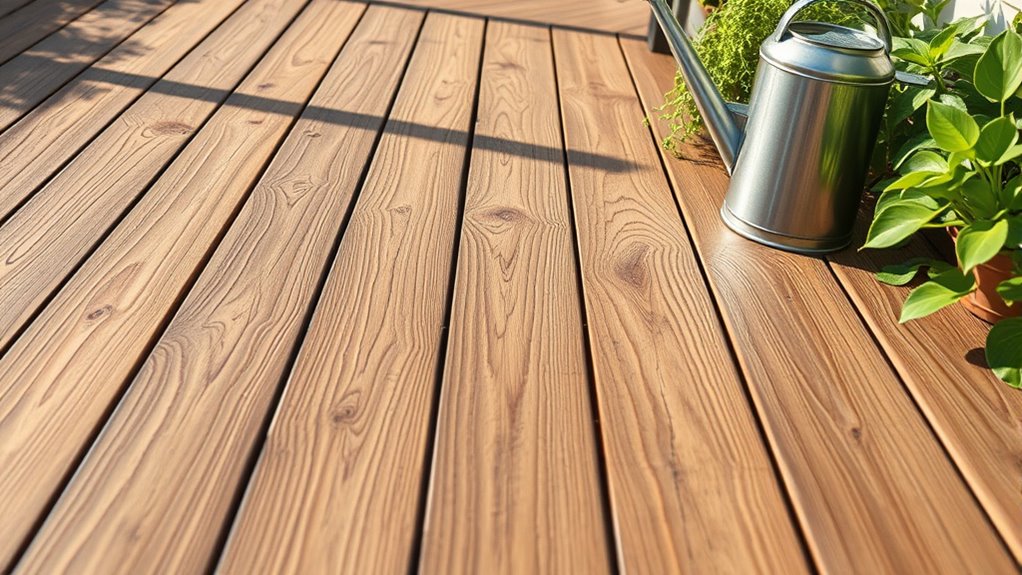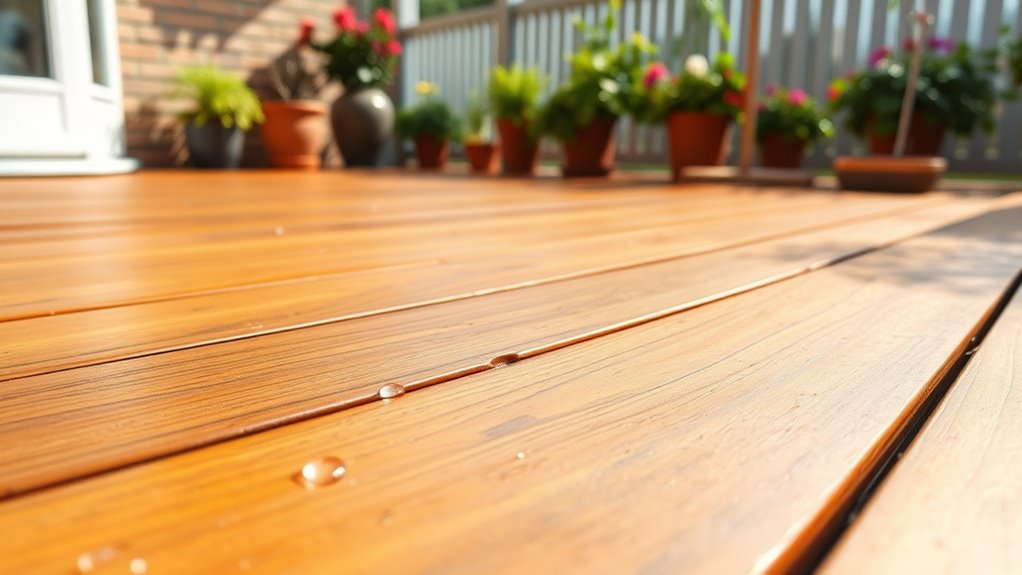To prevent rot on your wooden patio, you should regularly inspect it for damage and promptly replace any decayed boards. Keep your surface clean by sweeping and washing with specialized wood cleaners, and sand rough spots before sealing. Apply waterproofing sealers when the wood is dry, reapplying every few years. Also, manage moisture by ensuring proper drainage and avoiding trapped water under furniture and planters. Continue exploring these tips for longer-lasting, rot-free results.
Key Takeaways
- Regularly inspect and replace decayed or damaged boards to prevent moisture intrusion and decay.
- Keep the surface clean and dry by sweeping and using appropriate wood cleaners, avoiding standing water.
- Ensure proper sealing and waterproofing with suitable sealers, reapplying every 1 to 3 years for protection.
- Maintain good drainage around the patio and avoid water pooling by rearranging furniture and planters.
- Trim nearby vegetation and use protective coverings like umbrellas to minimize exposure to excess moisture and sun.

Are you taking the right steps to keep your wooden patio in top condition? Proper maintenance is vital to prevent rot, which can compromise the structure and aesthetic of your outdoor space. Start by inspecting your patio annually. Look for warped, cracked, or loose boards, and replace any that show signs of decay or rot immediately. This keeps the overall integrity of your patio intact. Check all fasteners—nails and screws—and tighten or replace them as needed to guarantee boards stay firmly in place. If you notice cracks or holes, fill them with wood fillers or caulk, then sand smooth before refinishing to create a seamless surface. Regularly remove debris like leaves and dirt, as moisture trapped underneath can accelerate rot and promote mold growth. Proper drainage around the patio is essential to prevent water from pooling and seeping into the wood, which significantly reduces the risk of rot. Cleaning is a key part of maintaining your wooden patio. Sweep the surface regularly to clear away dirt, dust, and leaves that can hold moisture. When it’s time for a deeper clean, use a wood deck cleaner mixed according to manufacturer instructions. Scrubbing with a stiff brush on stained or mold-affected areas helps lift stubborn dirt or mold spores. Rinse thoroughly with a garden hose, making sure no cleaner residue remains, since leftover chemicals can attract more dirt or lead to discoloration. Avoid chlorine bleach; instead, opt for oxygen bleach or specialized wood cleaners, which are gentler and help preserve the wood’s natural tones. Before sealing or staining, lightly sand the wood to remove splintery or fuzzy patches caused by weathering or cleaning. Use 80-grit sandpaper on a pole sander for even results without damaging the fibers. Only sand dry boards—wait up to 48 hours after washing to ensure complete dryness. Smooth out raised edges and filling materials to create an even surface, but avoid over-sanding or using power sanders, as this can harm the wood. Sealing and waterproofing are vital to prevent moisture infiltration. Apply a waterproofing sealer or stain only when the wood is completely dry and clean. Use a pump sprayer for even coverage, and allow the sealer to cure for at least 24 hours. Reapply every 1 to 3 years, depending on your climate and foot traffic. For longer-lasting protection, choose clear sealers, but remember that tinted stains may fade more quickly over time. Managing sunlight and moisture around your patio also helps prevent rot. Rearrange furniture and planters periodically to avoid water pooling and uneven sun exposure. Use synthetic mats instead of natural fiber rugs to prevent trapped moisture. Keep bushes and trees trimmed, maintaining at least a 12-inch clearance to reduce mold and moss growth. Installing umbrellas or pergolas can shield your wood from excessive sun and rain. Ensure proper drainage underneath and around your patio to prevent standing water, which can seep into the wood and cause decay. Understanding how moisture affects wood can help you take proactive steps to protect your outdoor space effectively.
Frequently Asked Questions
How Often Should I Reseal My Wooden Patio?
You should reseal your wooden patio based on its usage, climate, and sealant type. Generally, high-traffic or exposed decks need resealing every 1 to 2 years, while milder conditions allow up to 3 to 4 years. If you notice cracking or water no longer beads, it’s time to reseal. Regular inspections and maintenance help you determine the best resealing schedule, ensuring your patio stays protected and beautiful.
Can I Use Pressure Washing on My Wooden Patio?
Did you know that improper pressure washing can cause irreversible damage to your wooden patio? You can use a pressure washer, but only at low pressure around 1800 PSI, with a wide fan nozzle and proper distance. Keep the spray moving, avoid high pressure, and test on an inconspicuous spot first. This careful approach helps clean effectively without harming your wood or trapping moisture that promotes rot.
Which Types of Wood Are Most Resistant to Rot?
You want to know which woods resist rot best. Tropical hardwoods like Ipe, teak, and Cumaru top the list, thanks to their density and natural oils, making them ideal for outdoor use. North American options like white oak and black locust also offer excellent resistance. Softwoods such as Western Red Cedar and California Redwood naturally resist decay, making them reliable choices. Always consider treatment or certification for added durability.
How Do I Identify Early Signs of Wood Rot?
So, you’re enthusiastic to catch wood rot early? It’s not as obvious as it sounds. Look for soft, spongy spots or discoloration—you know, the telltale signs of fungal fun. Smell for that musty odor, and tap with a screwdriver; if it’s crumbly, you’ve got trouble. Pay close attention to deck corners, posts, and near gutters—these spots love to hide rot, waiting to surprise you.
What DIY Methods Are Effective for Treating Rot?
To treat rot yourself, start by evaluating the damage and removing all visibly infected wood with saws or chisels. Clean the area thoroughly, then apply a borate-based fungicide with a brush, ensuring full coverage. For deeper treatment, drill small holes and inject antifungal solutions. Reinforce the wood with a hardener, let it dry, and seal the surface to prevent future moisture. Regular inspections help keep rot at bay.
Conclusion
By regularly inspecting and caring for your wooden patio, you can prevent rot and extend its lifespan. Some might think it’s too much work, but investing a little time now saves you money and frustration later. Remember, a well-maintained patio not only looks great but also provides a safe, enjoyable space for years to come. So, don’t wait—take small steps today, and you’ll reap lasting benefits without the hassle of costly repairs down the line.









